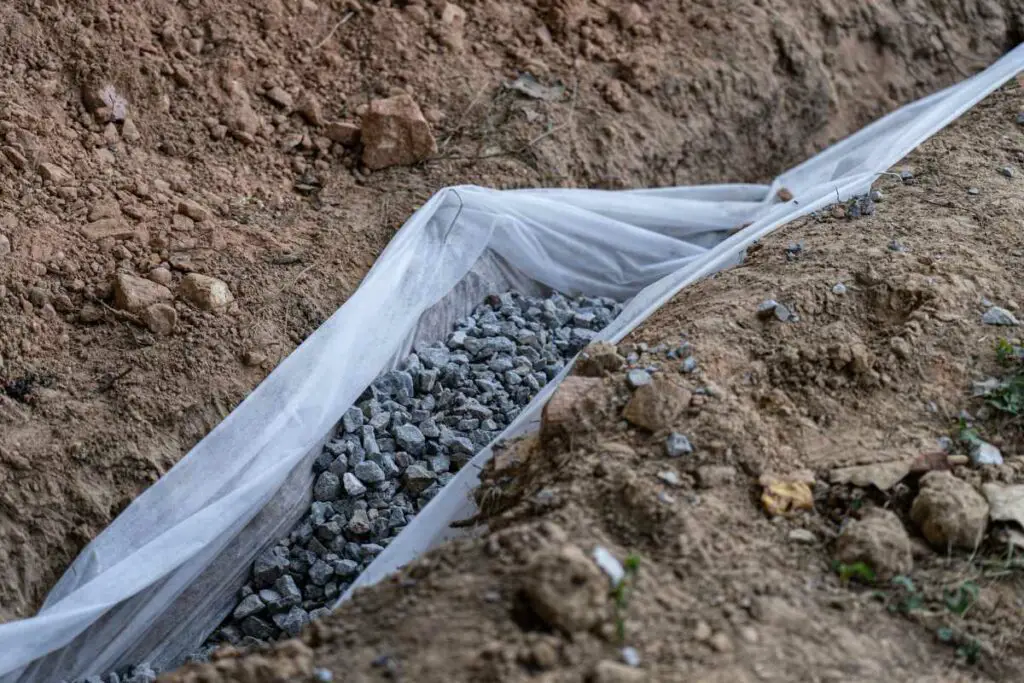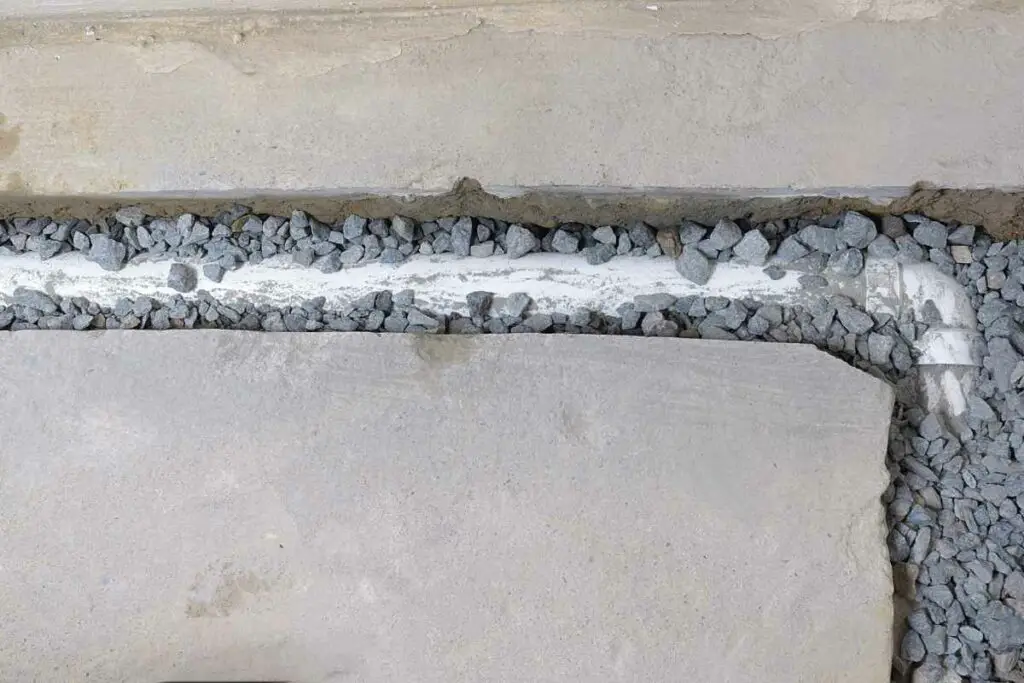French drains are a popular drainage system used to redirect water away from buildings, foundations, and other structures. They are named after Henry Flagg French, who popularized the concept in his 1859 book, “Farm Drainage.”
A French drain is essentially a trench filled with gravel or rock and a perforated pipe that directs water away from an area.
The pipe is usually covered with a geotextile fabric to prevent soil or debris from clogging the pipe. The trench can be dug at varying depths depending on the specific needs of the project, and the water is directed to a designated area where it can safely drain away.
French drains are often used to prevent water damage to foundations, basements, and crawl spaces, but they can also be used to improve the drainage of soggy lawns or to redirect water away from other structures.
They are a popular and effective solution for managing excess water and preventing water damage.
What is a French Drain?
A French drain is a drainage system that is designed to redirect water away from a property or building. It is essentially a trench that is filled with gravel or rock and contains a perforated pipe that allows water to flow through it.
The water is then redirected away from the property or building, preventing it from causing damage such as flooding or foundation damage.
The name “French drain” comes from Henry Flagg French, a Massachusetts farmer who popularized the technique in the mid-19th century.
French drains are commonly used in areas where there is heavy rainfall or where water tends to accumulate, such as in basements, crawl spaces, and yards.
The basic design of a French drain is simple. A trench is dug in the ground, sloping downward away from the property or building.
The trench is then filled with gravel or rock, and a perforated pipe is laid on top of the gravel. More gravel or rock is then added on top of the pipe, and the trench is covered with soil.
How Do French Drains Work?
French drains are designed to redirect water away from your property by creating a channel for water to flow through. They are typically installed in areas where water tends to pool, such as near the foundation of a house or in a low-lying area of a yard. Here is how they work:
- A trench is dug in the ground where the French drain will be installed.
- A perforated pipe is placed in the trench and covered with a layer of gravel or stone.
- The trench is then filled with more gravel or stone until it is level with the surrounding ground.
- When it rains, water flows into the trench and through the gravel or stone, which filters out debris and allows the water to enter the perforated pipe.
- The water then flows through the perforated pipe and away from the property.
French drains are effective at preventing water from pooling around the foundation of a house, which can cause damage over time.
They can also be used to prevent erosion in areas where water tends to collect.
However, it’s important to note that French drains are not a cure-all solution for all drainage problems. If you’re experiencing significant drainage issues, it’s best to consult with a professional to determine the best course of action.
Why Install a French Drain?
French drains are an effective way to manage water runoff and prevent soil erosion. If you’ve noticed water pooling in your yard, or if your basement or crawl space is damp or flooded, a French drain may be the solution you need.
Here are some of the top reasons to install a French drain:
- Prevent water damage: French drains can help prevent water damage to your home’s foundation, basement, or crawl space. By channeling water away from your home, you can avoid costly repairs and mold remediation.
- Reduce soil erosion: Heavy rain can cause soil erosion, which can damage your landscaping and create unsightly gullies in your yard. By installing a French drain, you can prevent soil erosion and keep your yard looking its best.
- Improve drainage: If you have a low spot in your yard that always seems to collect water, a French drain can help improve drainage and prevent standing water. This can make your yard more usable and enjoyable, especially during rainy seasons.
- Protect your investment: Your home is one of the biggest investments you’ll make in your lifetime. By installing a French drain, you can protect your investment and ensure that your home stays dry and safe for years to come.
Overall, a French drain is a smart investment for any homeowner who wants to protect their property and prevent water damage. Whether you’re dealing with a minor drainage issue or a major flooding problem, a French drain can help you take control of your water management and keep your home safe and dry.
Types of French Drains
Surface French Drains

Surface French drains are typically used to remove standing water from flat surfaces such as driveways, patios, and walkways.
They are installed by digging a shallow trench and lining it with landscape fabric. Then, a layer of gravel is added, followed by a perforated pipe.
Finally, the trench is filled with gravel and covered with soil or sod. Surface French drains are effective in removing water from the surface, but they are not suitable for removing water from the subsurface.
Subsurface French Drains

Subsurface French drains are installed underground to remove water from the subsurface. They are typically used to prevent water from seeping into basements, crawl spaces, and foundations.
Subsurface French drains are installed by digging a trench around the perimeter of the area to be drained. The trench is lined with landscape fabric, and a layer of gravel is added.
A perforated pipe is placed on top of the gravel, and the trench is filled with more gravel. The excess water flows through the perforated pipe and is carried away from the area.
Subsurface French drains can also be used to drain water from low-lying areas in the yard. In this case, the trench is dug in a zigzag pattern across the area to be drained.
The trench is lined with landscape fabric, and a layer of gravel is added. A perforated pipe is placed on top of the gravel, and the trench is filled with more gravel.
The excess water flows through the perforated pipe and is carried away from the area.
Overall, the type of French drain you choose will depend on the specific drainage problem you are trying to solve. Surface French drains are ideal for flat surfaces, while subsurface French drains are better suited for subsurface drainage problems.
Installation Process
The installation process of a French drain involves several steps. Here are the general steps involved in installing a French drain:
- Step 1: Plan the Drainage System – The first step is to plan the drainage system. You need to determine the location of the drain, the depth, and the slope of the drain. The slope should be at least 1% to ensure proper drainage.
- Step 2: Dig the Trench – Once you have planned the drainage system, the next step is to dig the trench. The trench should be at least 6 inches wide and 18 inches deep. If you are installing a French drain around the foundation of your house, the trench should be dug to the depth of the footing.
- Step 3: Add Gravel – After digging the trench, add a layer of gravel to the bottom of the trench. The gravel should be at least 2 inches deep.
- Step 4: Lay the Pipe – Next, lay the perforated pipe on top of the gravel. The perforated side of the pipe should be facing down. The pipe should be sloped towards the outlet.
- Step 5: Cover with Gravel – Cover the pipe with gravel, leaving at least 2 inches of space at the top of the trench.
- Step 6: Add Filter Fabric – To keep the French drain free of dirt, silt, and tree roots, lay water-permeable filter fabric or a weed barrier over the gravel bedding in the trench.
- Step 7: Backfill the Trench – Finally, backfill the trench with soil, leaving at least 2 inches of space at the top of the trench. The soil should be sloped away from the foundation of your house.
It is important to note that the installation process of a French drain may vary depending on the specific situation.
This is the perfect Fabric sold on Amazon for french Surface drains – Click here for prices
For example, if you are installing a French drain in a yard, you may need to add a dry well to the drainage system to prevent water from pooling in the yard. It is recommended to consult a professional if you are unsure about the installation process.
Maintenance and Repair
French drains require regular maintenance to ensure they continue to function properly. Over time, debris and sediment can accumulate in the drain, leading to clogs and reduced water flow.
To prevent this, it’s important to clean out and snake the French drain at least once a year. This will remove any buildup and keep the drain clear.
If you notice any signs of damage or deterioration to your French drain, it’s important to address the issue as soon as possible.
Neglecting repairs can lead to more serious problems down the line, such as water damage to your home’s foundation. Common issues that may require repair include cracks in the drain pipes, collapsed pipes, and damage to the drain’s outlet.
Flexible french pipe is easier to install and replace old piping – Price here on Amazon
In some cases, it may be possible to repair the French drain without having to replace the entire system.
For example, if there is a small crack in the pipe, it may be possible to patch it with a sealant. However, in more severe cases, it may be necessary to replace the damaged section of the drain or even the entire system.
Regular maintenance and prompt repairs are key to ensuring your French drain continues to protect your home’s foundation from water damage.
By taking care of your drain, you can enjoy peace of mind knowing your home is protected from costly water damage.
Conclusion
French drains are an effective solution to redirect water away from your property and prevent flooding.
They have been used for over 150 years and have a proven track record of success. A French drain consists of a trench filled with gravel and a perforated pipe that allows water to flow freely. The trench is then covered with soil, and the water is directed away from the property.
The history of French drains dates back to the mid-19th century when Henry French, a farmer, invented the system to solve his own drainage problems.
Since then, French drains have evolved into a widely used drainage system that is effective in a variety of situations.
When considering a French drain system, it is important to consult with a professional to determine the best solution for your specific needs.
Factors such as soil type, slope, and the amount of rainfall in your area can all affect the effectiveness of a French drain system.
Overall, French drains are a reliable and effective solution for managing excess water and preventing damage to your property. With proper installation and maintenance, a French drain can provide years of protection and peace of mind.
